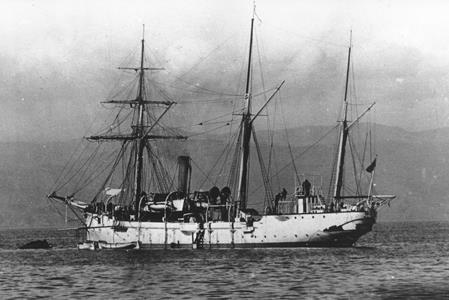TS Amokura was a training ship that was commissioned by the New Zealand government for the purposes of naval training. The name means ‘red-tailed tropic bird.’
Amokura was a training ship that was commissioned by the New Zealand government for the purposes of naval training. The name means ‘red-tailed tropic bird.’[1]
Ship details:[2]
Type: three-masted composite-screw Barquentine
Class: 1st class gunboat
Name: HMS Sparrow
Launched: 1889, completed 1890 at Greenock
Dimensions: 165ft (50m) x 31ft (9m) x 11’6” (4m)
Displacement: 805 tons (818 tonnes)
Machinery: coal fired, horizontal engines – single screw ihp 720 = 13 knots
Armament:
six x 4-inch (102mm) breech-loaders,
2 x 3-pdr Hotchkiss guns
2 x Nordenfelt machineguns
Complement: 76 officers, ratings and trainees
History:
As HMS Sparrow she saw service with the Royal Navy on the west coast of Africa as part of the colonial policing that was the lot of the late-Victorian navy. In 1891, under the command of Lieutenant Fraser she engaged with the ‘local natives’ on the Gambia River resisting the passage of the Anglo-French Boundary Commission upriver. In 1892, men from Sparrow, the sloop HMS Racer and the armed paddle vessel Alecto assaulted fortified strongholds of the Tambi and Toniatuba tribes that had attacked tribes protected by the British. In 1893 she moved the east coast of Africa to take part in punitive expeditions. Detachments were sent from Sparrow, the third-class cruiser HMS Blanche, and the sloop HMS Swallow. She was a unit in a fleet commanded by Rear-Admiral Rawson during the 1895-1896 Ashantee War. A civil war in Zanzibar following the death of the Sultan required the deployment of Rawson’s fleet. Along with HMS Philomel, Sparrow successfully engaged with the hostile fleet and a captured warship Glasgow.[3]
The New Zealand government passed the Training Ships Bill 1906 that authorised the expenditure of £820 and it was intended that the vessel be used for the training of boys aged between twelve and fourteen in seamanship.[4] Some raised objections that the ship was steam-powered, claiming that it would give ‘little opportunity for teaching boys a seafaring life.’[5] It cost the government £216 to run the ship per month and each boy received three pence as pocket money per week.[6] The first commanding officer was a merchant mariner Captain Frank A. Worsley appointed in March 1905. He brought the vessel from Sydney to Wellington and remained in command until he resigned in March 1906.[7] It cost a further £720 to bring the ship across the Tasman.[8] Captain G.E. Hooper was appointed to command and held that position for most of the ship’s commission.[9]
By March 1913, 220 boys had been trained on the vessel. Some had joined the RN ships HMS Challenger, Pioneer. Others joined the merchant navy as ordinary seamen.[10] The skill of Captain Hooper made for a successful training ship by:
“being a thoroughly-trained naval officer, combined tactfulness and understanding in his methods of dealing with the youths who sought personally to pierce the mysteries and investigate the romance of the sea.[11]”
By the end of the commission, 530 boys had served aboard Amokura between March 1907 and December 1921.[12]
Most of the sailing was done under canvas. The training voyages were from Wellington and in the latter part of the year went southwards as far as the Campbell and Auckland Islands. At the start of the year the ship went northwards visiting the Kermadecs and Great Barrier and would winter in Port Nicholson. The choice of voyages gave the boys rough-weather experience and gave them their ‘sea-legs’. Once they had gained this they were trained in all aspects of seamanship. The fact that many went on to successful careers in the merchant navy reinforced the value of the ship’s commission.[13]
By 1919 the ship was in a poor state and by 1921 the ship was not able to leave Wellington Harbour. The cost of repairs was prohibitive in an economically constrained post-war New Zealand. The British Government offered the ship HMS Diamond as a replacement, but due to the cost of conversion for training purposes the offer was declined.[14] The Economy Committee of 1921 delivered the final verdict on the ship stating that decommissioning was in line with the ‘curtailment of Departmental expenditure and the promotion of efficiency.’[15] The last commander of the vessel was Captain W. Burgess. Amokura was decommissioned in 1922 and was used as a coal hulk at Port Nicholson.[16]
[1] T.D. Taylor, New Zealand’s Naval Story, Wellington: A.H. and A.W. Reed, 1948, p. 177.
[2] ibid.
[3] ibid., pp. 182-183.
[4] ibid., p. 177.
[5] ibid., p. 178.
[6] ibid.
[7] ibid.
[8] ibid., p. 179.
[9] ibid., p. 178.
[10] ibid., pp. 179-180.
[11] ibid., p. 180.
[12] ibid., p. 183.
[13] ibid., p. 180.
[14] ibid., p. 181.
[15] ibid., p. 182.
[16] ibid., p. 180.

